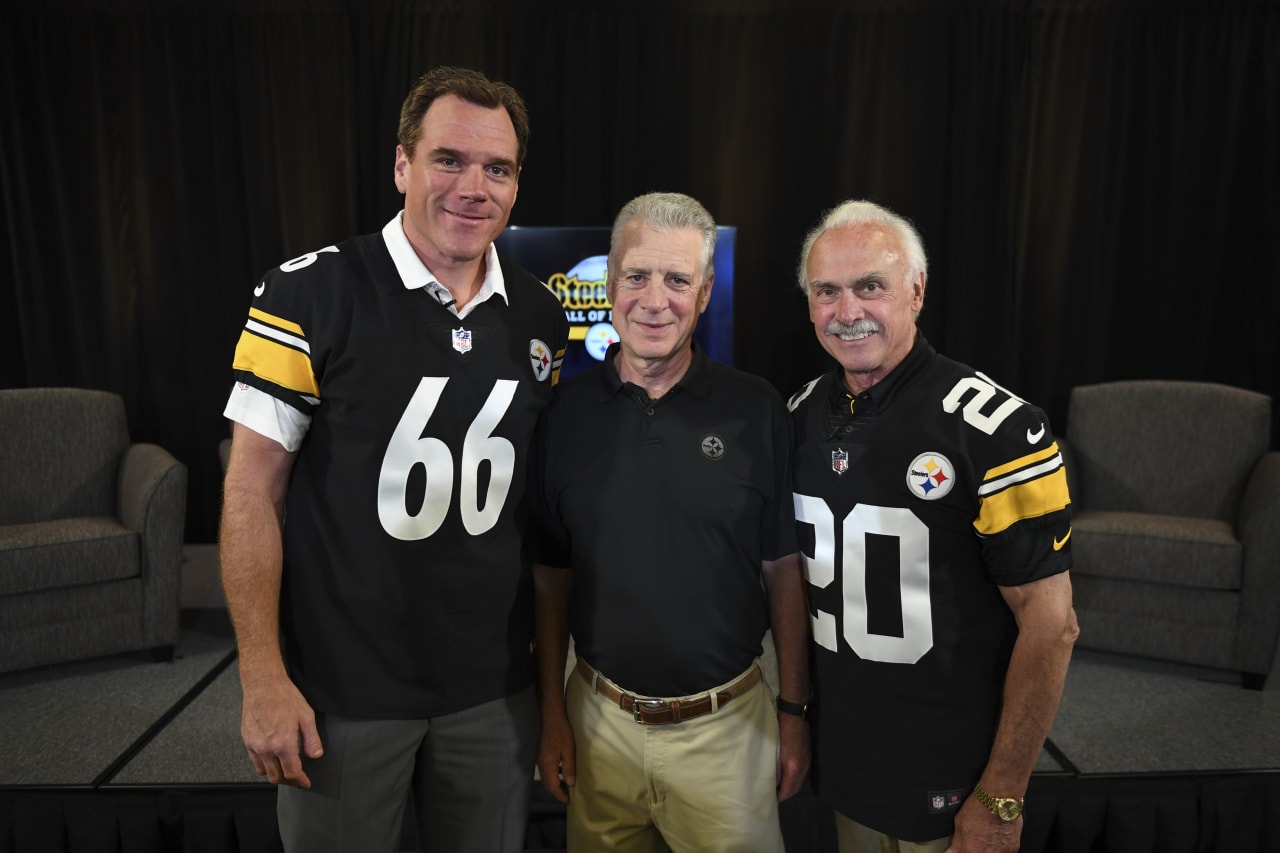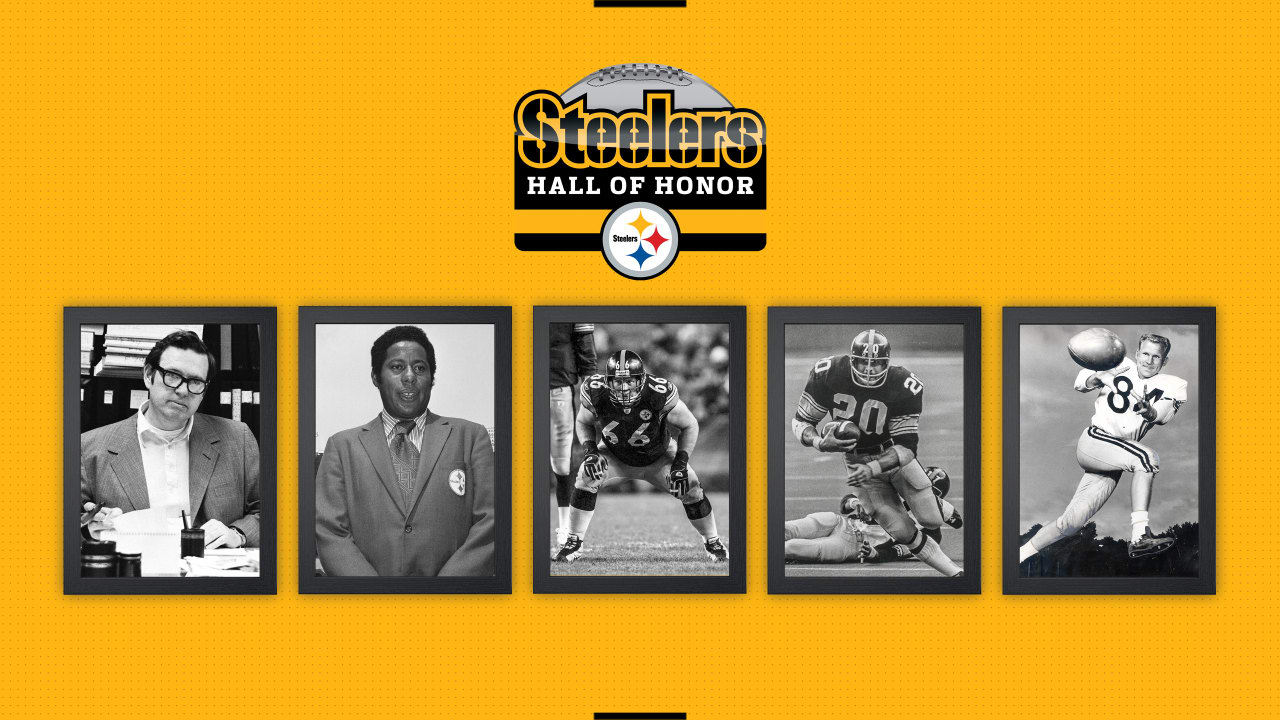By Teresa Varley
July 28, 2018

Alan Faneca, Art Rooney II and Rocky Bleier
They are Steelers legends. They made an impact on the team, on the organization. And they are an integral part of the Steelers rich history.
That is exactly why these five individuals will make up the second class of the team’s Hall of Honor, which was revealed today at a press conference held at Saint Vincent College.
“We wanted to recognize all of the great people that made Steelers football what it is today,” said Steelers President Art Rooney II. “It’s open to anybody who made a significant contribution to Steelers football. We had a tough selection process again this year. Five great Steelers and great contributors. We are excited to induct these guys into the Hall this year. It’s great to have people each year who some may be in Canton, many won’t be. It’s great to recognize them.”
The individuals who will be inducted into the Hall of Honor for 2018 include, in alphabetical order, Rocky Bleier, Buddy Dial, Alan Faneca, Bill Nunn and Art Rooney Jr.
“It’s something very special,” said Bleier, a 16th round draft pick who played 12 seasons for the Steelers, including being a member of four Super Bowl teams. “To be compared to all the great players who played for the organization, and have your name attached to theirs, is a great honor. In this game, everybody does a job and does it well. You like to get recognition, and I got a lot playing on those teams and winning the Super Bowls. That was enough for me. To be able to be a part of this distinction is truly a wonderful honor for me.”
Last year the team introduced the Hall of Honor, an idea that came from Steelers President Art Rooney II, along with late Chairman Dan Rooney. The Hall of Honor was established to recognize former players, coaches, and front office personnel who played an integral role in the success of the franchise, from the beginning in 1933 until now. To be considered, a player must be retired at least three years and played a minimum of three seasons for the Steelers. Former coaches and contributors had to make significant contributions to the team and community.
“The Steelers have always taken care of their own and praised their people in front of crowds and behind the scenes,” said Bleier. “Within that confine a gesture like this is really special to honor players for what they have done for the team and community.
“Just to play professional football is a dream come true, no matter when you played. As you look back, when you plan your life you say I want to play professional football, you think what would that look like? No one would ever say you would be a part of the greatest dynasty that won four Super Bowls and you played with all of those Hall of Famers. You were a part of that tradition.
“What better organization would there to be a part of than the Pittsburgh Steelers. I am proud to be a part of what they are today.”
The first class included the team’s Hall of Famers, as well as a select group of individuals. They were Jerome Bettis, Mel Blount, Terry Bradshaw, Jack Butler, Dermontti Dawson, Bill Dudley, Joe Greene, Kevin Greene, L.C. Greenwood, Jack Ham, Franco Harris, Dick Hoak, John Henry Johnson, Walt Keisling, Jack Lambert, Bobby Layne, John McNally, Chuck Noll, Arthur J. Rooney, Sr., Daniel M. Rooney, Andy Russell, Donnie Shell, John Stallworth, Ernie Stautner, Lynn Swann, Mike Webster, and Rod Woodson.
This year’s class is significantly smaller, which will be the norm moving forward. And to be a part of the Hall of Honor is something that means the world to Faneca, who has been a finalist for the Pro Football Hall of Fame the last three years.
“Being in the Hall of Honor, being in with the great players that came before me and the reputation the Steelers have. That is what hit me first,” said Faneca. “It is humbling. It hasn’t been that long since I played. It seems like a lifetime ago, but I have only been done playing seven years. It’s an honor.
Art called me and informed me. It caught me off guard. You don’t get those phone calls from Mr. Rooney every day. I knew something was up. I was excited.
“The Steelers are special. You get drafted, go somewhere, and looking back I realize how lucky I was to come to Pittsburgh. If I could go back to me at that point and let myself know how lucky I was to be a part of the Steelers, it would be amazing. Not knowing it at the beginning but learning it along the way was fun.”
And what Faneca learned along the way is that the Steelers are like no other.
“It’s like something in the water there,” said Faneca. “It’s so special. It has always been that way and it keeps getting passed along. It’s the people there, the people that work for the team, play for them, coach, the front office. It’s a family run business and that feeling permeates through the players and they put their heart and soul into the team.
“You see some teams have a ring of honor for just the elite of the elite. It’s not many that get that honor, and more deserve it. The way the Steelers are doing it is great. It’s the Pittsburgh way, the family way. We are a family and encompassing a broader group is a great way to do it. It’s why the Steelers are special.”
The 2018 Steelers Hall of Honor Induction ceremony will be held on Friday, Sept. 28, at Heinz Field, the weekend the Steelers host the Baltimore Ravens on Sunday Night Football (Sept. 30). All will be presented with a steel football, a replica of one presented to Art Rooney Sr. by the U.S. Steel Corporation at the team’s 50th Season celebration.
“It’s going to be exciting,” said Faneca. “Any time you are around the fans it’s special. When you stop playing, you miss the locker room first. But you miss the fans. Those moments are special. To come back and be with the fans, those moments are always special.”
* * *
The Hall of Honor Selection Committee consists of Steelers President Art Rooney II, Joe Gordon, Bob Labriola, Stan Savran, Andrew Stockey and Tony Quatrini.

Rocky Bleier: Running Back (1968, 1970-80)
Football often is compared to war by the overly-dramatic. Rocky Bleier knows the difference. A 16th-round draft choice by the Steelers in 1968 as a halfback out of Notre Dame, Bleier also was drafted by the U.S. Army in 1969. Eventually shipped overseas, Bleier was wounded in combat during the Vietnam War. Awarded the Bronze Star and a Purple Heart for his military service, Bleier then began the arduous rehabilitation process on his foot that would enable him to return to professional football. Known primarily as a blocker, Bleier finished with 3,855 yards rushing, including 1,036 in 1976 when both he and Franco Harris finished the seson with over 1,000 yards rushing. Still ranked ninth of the team’s all-time rushing list, Bleier also finished his career with two touchdown receptions in the playoffs, including an acrobatic one in Super Bowl XIII.
Buddy Dial: Wide Receiver (1959-63)
If average yards per catch is used as the criteria, Buddy Dial was the foremost big-play receiver in franchise history. Dial played his first five NFL seasons with the Steelers, and he amassed 4,723 receiving yards on 229 receptions (20.6 average). He was the first receiver in Steelers history to post a 1,000-yard receiving season, and he did it twice (1,047 yards in 1961 and 1,295 yards in 1963). His 20.6-yard average is the highest in team history, and he added 42 receiving touchdowns to his Pittsburgh resume. Upon leaving the Steelers for Dallas following the 1963 season, his 42 touchdowns were a team record. Dial was voted to the 1962 Pro Bowl.
Alan Faneca: Guard (1998-2007)
During the days leading up to the 1998 NFL Draft, Jimmy Johnson was surveying the pool of talent. Then the Dolphins coach, Johnson had much draft-day success when he built the Cowboys championship teams of the early 1990s. “The guy most ready to play in the NFL,” Johnson told a reporter, “is that kid Faneca from LSU.” The Steelers picked Alan Faneca in the first round of the 1998 draft, and he deserves to be recognized as one of the best offensive linemen in franchise history. Faneca was a six-time first-team All-Pro during his years with the Steelers, and he was voted to nine Pro Bowls overall. In 2003, Faneca exhibited uncommon versatility by playing nine games at left tackle when injuries ravaged the line. He was named a member of the Steelers All-Time Team, and a member of the NFL Team of the Decade (2000s).
Bill Nunn: Scout, Assistant Director Player Personnel, Senior Scout (1968-2014)
Before accepting Dan Rooney’s job offer in 1968, Bill Nunn was a newspaper guy – first a sports writer, then the sports editor, then the managing editor of The Pittsburgh Courier during an era when it was one of the most influential black publications in America. Starting in 1950, Nunn personally selected the annual Black College All-America Football Team for The Pittsburgh Courier, and in the course of performing that duty he developed relationships with players and coaches at those colleges that would serve him well during his career in the NFL. Before the rest of the league caught on to the wealth of talent available in the programs at the Historically Black Colleges, Nunn helped the Steelers add many players who would go on to fill integral roles in the four Super Bowl championship teams of the 1970s. Included among those were L.C. Greenwood from Arkansas AM&N, Mel Blount from Southern, Frank Lewis from Grambling State, Dwight While from Texas A&M-Commerce, Ernie Holmes from Texas Southern, Joe Gilliam from Tennessee State, John Stallworth from Alabama A&M, and Donnie Shell from South Carolina State. For his decades of service, Nunn was enshrined as a member of the Inaugural Class of the Black College Football Hall of Fame.
Art Rooney Jr.: Personnel Director (1965-1986) ; Vice President (1987-Current)
During Buddy Parker’s eight-year reign as the Steelers coach from 1957-64, the team posted five winning seasons while showing a complete disdain for the NFL Draft. Parker traded away the team’s draft picks in droves, and during his tenure that included four first-round picks and five second-round picks. Of the top 40 potential draft picks during his eight seasons as coach (Rounds 1 though 5 each year), Parker traded away 40 of those. That changed when Parker was fired in 1965, and it was the start of the Steelers turning to the draft as their primary method of roster-building, a philosophy that continues to this day. It also was when Art Rooney Jr. was hired as the team’s Personnel Director. When Chuck Noll became the coach in 1969, he teamed with a Scouting Department headed by Art Rooney Jr. to draft nine Hall of Fame players, in addition to adding 11 more (nine draft picks and two undrafted rookies) from 1969-74 who would earn four Super Bowl rings with the team during the 1970s.


No comments:
Post a Comment